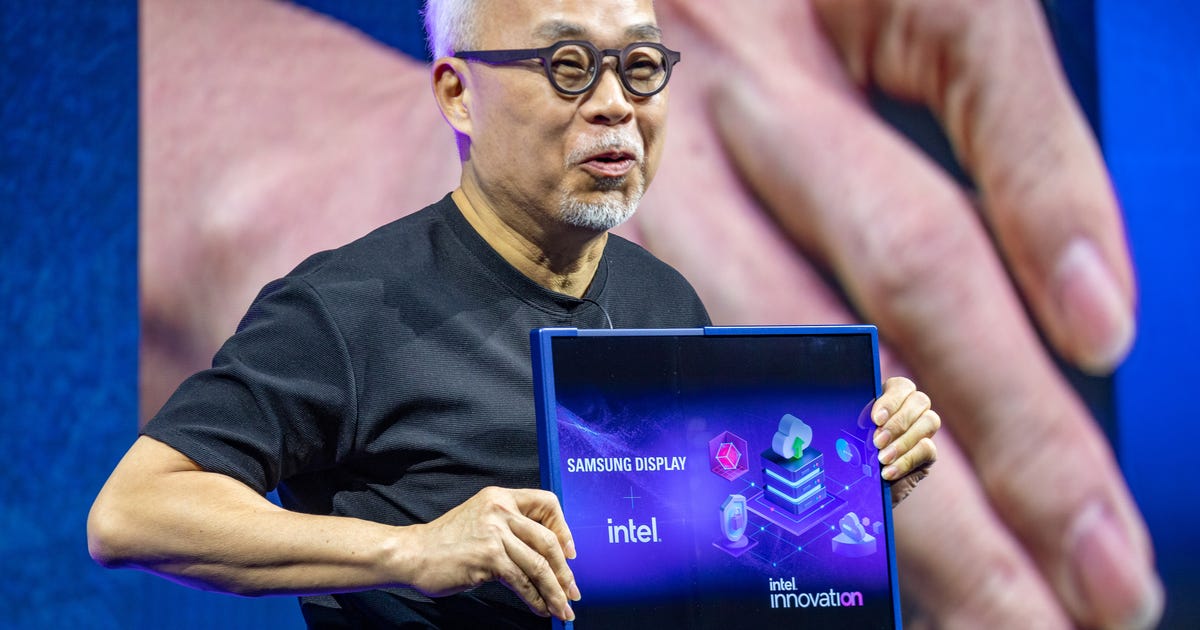
[ad_1]
Intel and Samsung have another new idea for how to make a computer: a “sliding” device with a screen that expands to a much larger size when you pull the edge.
Lacking a keyboard, the slide-out computer looked more like a tablet. But with a screen diagonal of 13 inches to 17 inches, it was bigger as a laptop. Intel Chief Executive Pat Gelsinger and JS Choi, head of Samsung’s display division, showed off the device on Tuesday at Intel Innovation, a conference where the company also made its debut. Intel’s new 13th Generation Core processors.
A sliding computing device will satisfy needs for both a large screen and portability, Gelsinger said. It is a demonstration of what is possible with OLED display technology, which is built on a flexible plastic substrate.
It’s not clear when or even if the sliding computer idea will mature into a product. But the design shows how the computer industry continues to try new hardware to expand beyond traditional snap-on laptops with a keyboard and screen connected by a hinge. Other examples include laptops whose screens flip all the way back to convert the device into a tablet and the ThinkPad X1 Foldwith a folding screen.

Intel CEO Pat Gelsinger shows how the screen of a “sliding” computer can extend from 13-inch diagonal to 17-inch diagonal.
Stephen Shankland/CNET
Moving parts and flexible components increase the challenges of complexity and reliability. Costs are also increasing, worry during a declining computer market. But new designs can find a niche, and high-end PCs are doing better than budget PCs, Michelle Johnston Holthaus, head of Intel’s computer chip group, said at the conference.
earlier this year, Samsung showed a sliding phone screen along with other new designs.
Although the slide-out PC prototype did not have a keyboard, one could be added as the design matures, for example by folding out from the bottom, Holthaus said.
A close-up view of Intel and Samsung’s sliding PC prototype shows some ripples on the left side of the flexible display, the area that curves when the device is pushed back into its shortened configuration.
Stephen Shankland/CNET
Welcome, Raptor Lake processors
Also at the event, Gelsinger showed off the new Raptor Lake processors, which are scheduled to hit store shelves on October 20. The processors speed up the CPU cores dedicated to high-priority tasks and double the number of CPU cores dedicated to lower-priority operations. jobs more efficiently.
The new chips reach new speeds, with a clock that beats as fast as 5.8GHz, but they also draw more power in desktop machines. Expect an improvement in 2023: “At the beginning of next year we will release a [model] that hits 6 gigahertz out of the box for the first time,” although Intel will ship it only in limited volumes, Gelsinger said.
Computer processors are key to Intel’s future, but the company faces fierce competition. AMD has eroded Intel’s dominance, especially in the high-end gaming PC market, and AMD’s Ryzen 7000 line promises significant rapid acceleration.
Apple, which has kicked Intel out of its Mac laptops and desktops in favor of its own M1 and M2 processors, is another challenge for Intel.
“They are a formidable competitor, and they have a good part. Our goal is to build a part that is just as good,” Holthaus said. “As you see future generations, when you think about performance per watt, we will have products that absolutely compete with Apple.”
[ad_2]
Source link
